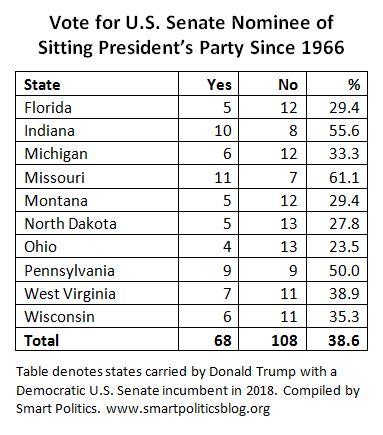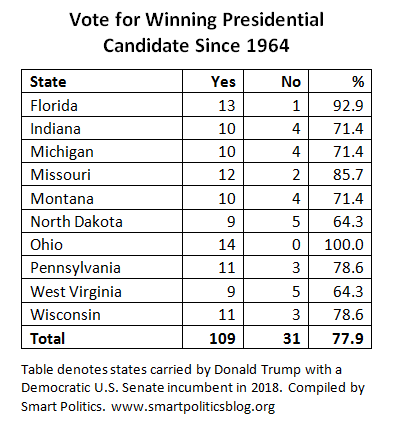How Many Trump States Will Back Democratic US Senate Nominees in 2018?
The 10 Trump states with Democratic incumbents have voted for senate nominees from the opposing party of the sitting president 62 percent of the time over the last 50 years

As such, the electoral discussion has largely revolved around the extent to which Democrats can blunt Republican gains across the 23 seats it must defend next year (along with two independents that caucus with the party) particularly if Donald Trump’s approval ratings remain in the high 30s to low 40s at the time of the midterm election.
Ten of these 23 states with Democratic incumbents were carried by Trump in 2018: Florida (Bill Nelson), Indiana (Joe Donnelly), Michigan (Debbie Stabenow), Missouri (Claire McCaskill), Montana (Jon Tester), North Dakota (Heidi Heitkamp), Ohio (Sherrod Brown), Pennsylvania (Bob Casey), West Virginia (Joe Manchin), and Wisconsin (Tammy Baldwin).
So just how well does the president’s party fare in U.S. Senate races?
Looking broadly at the data, Smart Politics examined the nearly 1,900 U.S. Senate elections conducted since 1913 and found that the party of the sitting president has managed to win nearly half of U.S. Senate contests – 894 out of 1,881 contests, or 47.5 percent.
Of course, if the 2018 cycle approximates that historical average, Donald Trump and the Republicans will be sitting pretty after Election Day with such a disproportionate number of Democratic seats appearing on the ballot.
Winning 47.5 percent of the 33 seats on the ballot next year would net the GOP seven seats, bringing their total to a near filibuster-proof 59 in the chamber.
That, however, would require Republicans nearly running the table on those aforementioned vulnerable Democratic seats in Trump states – something the party is not likely to accomplish while the president’s approval rating hovers in the high 30s to low 40s.
Moreover, when looking through the lens of more recent political history, the less likely it seems that the GOP is going to flip several states next year.
Over the last 50 years, the 10 states carried by Trump with Democratic incumbents have voted for the U.S. Senate nominee of the sitting president in just 68 of 176 races (38 percent).
Among these 10 states, the party controlling the White House has fared poorest in Ohio’s U.S. Senate elections over the last half-century, winning just four of 17 races (23.5 percent).
The president’s party was defeated for U.S. Senator in the Buckeye State in 1968, 1974, 1976, 1982, 1986, 1988, 1992, 1994, 1998, 2000, 2006, 2010, and 2016.
The four exceptions occurred when the state elected Republicans Robert Taft, Jr. (1970) and George Voinovich (2004) and Democrats John Glenn (1980) and Sherrod Brown (2012).
Meanwhile, North Dakotans have voted against the party of the sitting president in 13 of 18 cycles over the last 50 years (72.2 percent): in 1968, 1970, 1976, 1980, 1982, 1986, 1988, 1992, 1992 (special), 2004, 2006, 2010, and 2016.
The lone exceptions arose when the state voted for Republican Milton Young (1974) and Democrats Kent Conrad (1994, 2000), Byron Dorgan (1998), and Heidi Heitkamp (2012).
The president’s party has also struggled in U.S. Senate elections in Montana and Florida, winning just five of 17 races since 1966 in both states (29.4 percent).
Nominees from the White House’s party lost in Montana in 1970, 1972, 1976, 1982, 1984, 1990, 1994, 2000, 2002, 2006, 2008, and 2014 with victories coming only in 1966 (Lee Metcalf), 1978 (Max Baucus), 1988 (Conrad Burns), 1996 (Baucus), and 2012 (Jon Tester).
Floridians backed the opposing party in 1968, 1970, 1974, 1976, 1980, 1982, 1986, 1992, 1994, 2006, 2010, and 2016 and the president’s party in 1988 (Connie Mack), 1998 (Bob Graham), 2000 (Bill Nelson), 2004 (Mel Martinez) and 2012 (Nelson).
Voters in Michigan, West Virginia, and Wisconsin only backed nominees from the sitting president’s party in 19 of 53 races collectively (35.8 percent).
Among these 10 Trump states, three aligned their senate vote with the party of the sitting president at least half the time: Pennsylvania (9 of 18 races), Indiana (10 of 18), and Missouri (11 of 18).
Of course, it’s theoretically possible that the reason these 10 states voted against the party of the sitting president in these senate races is because they frequently did not vote for the winning presidential candidate in the first instance.
But that’s not the case.
What’s striking is that these 10 states voted for the winning presidential nominee in 108 out of 140 elections over the last 14 presidential election cycles (LBJ through Trump), or 77.1 percent of the time.
Ohio backed the eventual presidential winner in each of the last 14 elections with Florida doing so 13 times, Missouri 12, Pennsylvania and Wisconsin 11, Indiana, Michigan, and Montana 10, and North Dakota and West Virginia nine.
As for the two states with GOP U.S. Senators that Democrats are hoping to make competitive next year, the numbers don’t look much better for the GOP with the states backing the party of the sitting president in U.S. Senate races just 41 percent of the time since 1966 (six of 17 contests in Arizona, and eight of 17 in Nevada).
Follow Smart Politics on Twitter.



1. NV: The Silver State gave 539260 votes to “Her” versus 512058 votes to “T” (per his recent Tweet!); indeed, 2016 was one of only three occasions over the last half-century that it has failed to back the winner (the others are 1976 and 2000).
2. The DNL (Democratic Nonpartisan League) of the PeaceGarden/RoughRider State did not win any Senate election (regular or special) in 2008 (‘W’s last full year in office) – though it surely would have. Given the (perceived) anti-fossil-fuels energy stance and anti-rural-folk image of its national counterpart, the party’s remarkable hold on the Class 1 seat (continuously since August 1960, less than five years after the merger of the Non Partisan League and the Democratic Party) seems to be at great risk next year, whatever his national numbers, and Heitkamp’s personal favourability score may be then.
3. MT: Will Tester finally become a majority (statewide vote) senator, or is he poised to become just the second three-time plurality senator in history?
4. Of these 10 ‘T/D split’ states, MO may well be the most probable takeaway state for the party; unlike Manchin and even Donnelly, two-termer McCaskill has voted down line (e.g. against Neil Gorsuch for that ‘stolen’ SCOTUS vacancy, and nay on Jefferson Beauregard Sessions III for USAG) even as her party has lost not only at the federal level, but also, contrary to expectations, ceded the posts of governor and attorney general as well. Too, her likely principle opponent (from Saint Louis County) is highly unlikely to be the type of challenger that Congressman Todd Akin was.
RE: #2. Yes, Byron Dorgan’s election in ’98 (not ’08).
Actually, ‘1976, 2000, 2016’ applies to the Enchantment state; in 2000 the Silver State backed “W” – without which he would not have become POTUS “43”!
At this (early) stage, the first-line seats seem to be the D-held MO (mentioned in an earlier post), IN, and WV, and the R-held NV; the next tier arguably comprise of DEM seats in MT, ND, WI, MI, OH, PA, and FL, and GOP seat in AZ. Of course, this assessment (and the excellent aforementioned outlook, too, for that matter) fails to figure in any casual vacancies that may occur (e.g. retirements, deaths, resignations, primary defeats).
The differences between husker Rick Scott and Senator Bill Nelson. Scott has never done anything for the people who cast their vote for him. Senator Bill Nelson is a true public servant and worked for the benefit of all people in Florida for three decades. There is also that small matter that Rick Scott earned his wealth by cheating Medicare.
Ever since college, I have been a libertarian – socially liberal and fiscally conservative. I believe in individual liberty and personal responsibility.